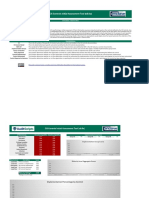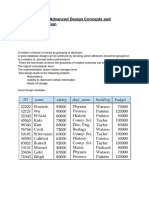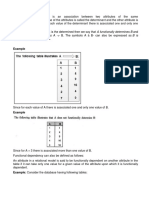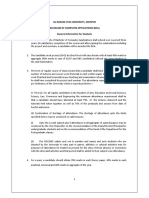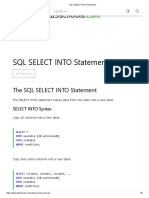0 ratings0% found this document useful (0 votes)
98 viewsFunctional Dependency
A functional dependency defines a constraint between attribute sets in a relation where a determinant set determines a dependent attribute. The closure of functional dependencies includes the original dependencies plus any that can be logically derived using Armstrong's axioms. Normalization aims to avoid anomalies by decomposing relations based on their functional dependencies.
Uploaded by
classCopyright
© © All Rights Reserved
Available Formats
Download as PPTX, PDF, TXT or read online on Scribd
0 ratings0% found this document useful (0 votes)
98 viewsFunctional Dependency
A functional dependency defines a constraint between attribute sets in a relation where a determinant set determines a dependent attribute. The closure of functional dependencies includes the original dependencies plus any that can be logically derived using Armstrong's axioms. Normalization aims to avoid anomalies by decomposing relations based on their functional dependencies.
Uploaded by
classCopyright
© © All Rights Reserved
Available Formats
Download as PPTX, PDF, TXT or read online on Scribd
You are on page 1/ 14
Definition
A functional dependency is defined as a
constraint between two sets of attributes in a
relation from a database.
Given a relation R, a set of attributes X in R is
said to functionally determine another
attribute Y, also in R, (written X → Y) if and
only if each X value is associated with at most
one Y value.
In other words….
X is the determinant set and Y is the dependent
attribute. Thus, given a tuple and the values of
the attributes in X, one can determine the
corresponding value of the Y attribute.
Example
Employee
SSN Name JobType DeptName
557-78-6587 Lance Smith Accountant Salary
214-45-2398 Lance Smith Engineer Product
Note: Name is functionally dependent on SSN because an employee’s name
can be uniquely determined from their SSN. Name does not determine SSN,
because more than one employee can have the same name..
Keys
Whereas a key is a set of attributes that uniquely
identifies an entire tuple, a functional
dependency allows us to express constraints that
uniquely identify the values of certain attributes.
However, a candidate key is always a determinant,
but a determinant doesn’t need to be a key.
Closure
Let a relation R have some functional dependencies F
specified. The closure of F (usually written as F+) is
the set of all functional dependencies that may be
logically derived from F. Often F is the set of most
obvious and important functional dependencies and
F+, the closure, is the set of all the functional
dependencies including F and those that can be
deduced from F. The closure is important and may,
for example, be needed in finding one or more
candidate keys of the relation.
Example
Student
SNo SName CNo CName Addr Instr. Office
5425 Susan 102 Calc I …San P. Smith B42
Ross Jose, Room
CA 112
7845 Dave 541 Bio 10 ...San L. Talip B24
Turco Diego, Room
CA 210
SNo -> SName CNo -> CName Instr -> Office
SNo -> Addr CNo -> Instr
Axioms
Before we can determine the closure of the
relation, Student, we need a set of rules.
Developed by Armstrong in 1974, there are six
rules (axioms) that all possible functional
dependencies may be derived from them.
Axioms Cont.
1. Reflexivity Rule --- If X is a set of attributes and
Y is a subset of X, then X Y holds.
each subset of X is functionally dependent on X.
2. Augmentation Rule --- If X Y holds and W is
a set of attributes, then WX WY holds.
3. Transitivity Rule --- If X Y and Y Z holds,
then X Z holds.
Derived Theorems from Axioms
4. Union Rule --- If X Y and X Z holds, then
X YZ holds.
5. Decomposition Rule --- If X YZ holds, then
so do X Y and X Z.
6. Pseudotransitivity Rule --- If X Y and WY
Z hold then so does WX Z.
Back to the Example
SNo SName CNo CName Addr Instr. Office
Based on the rules provided, the following dependencies can be
derived.
(SNo, CNo) SNo (Rule 1) -- subset
(SNo, CNo) CNo (Rule 1)
(SNo, CNo) (SName, CName) (Rule 2) -- augmentation
CNo office (Rule 3) -- transitivity
SNo (SName, address) (Union Rule)
etc.
Too Many FDs
Using the first rule alone, from our example we
have 2^7 = 128 subsets. This will further lead to
many more functional dependencies. This defeats
the purpose of normalizing relations.
So what now?
One way is to deal with one attribute or a set of
attributes at a time and find its closure (i.e. all
functional dependencies relating to them). The
aim of this exercise is to find what attributes
depend on a given set of attributes and therefore
ought to be together.
Normal Form
• Initially Codd (1972) presented three normal forms
(1NF, 2NF and 3NF) all based on functional
dependencies among the attributes of a relation.
Later Boyce and Codd proposed another normal form
called the Boyce-Codd normal form (BCNF). The
fourth and fifth normal forms are based on multi-
value and join dependencies and were proposed
later.
• The primary objective of normalization is to avoid
anomalies.
You might also like
- Functional Dependencies and NormalizationNo ratings yetFunctional Dependencies and Normalization7 pages
- CIS Controls Initial Assessment Tool (V8.0a) : Instructions - Read Me FirstNo ratings yetCIS Controls Initial Assessment Tool (V8.0a) : Instructions - Read Me First21 pages
- Delphi - Database Desktop Users Guide PDFNo ratings yetDelphi - Database Desktop Users Guide PDF171 pages
- Functional Dependency: T T T (A) T (A) T (B) T (B)No ratings yetFunctional Dependency: T T T (A) T (A) T (B) T (B)8 pages
- Lecture 3 Functional Dependancy +closureNo ratings yetLecture 3 Functional Dependancy +closure35 pages
- Database Design - Functional DependenciesNo ratings yetDatabase Design - Functional Dependencies12 pages
- Functional Dependencies and Normalization4No ratings yetFunctional Dependencies and Normalization486 pages
- UNIT-3DBMS (Normalization and Functional Dependency)No ratings yetUNIT-3DBMS (Normalization and Functional Dependency)34 pages
- 5 - Chapter 3 - Functional DependenciesNo ratings yet5 - Chapter 3 - Functional Dependencies26 pages
- MODULE-3 DBMS CS208 NOTES (Ktuassist - In)No ratings yetMODULE-3 DBMS CS208 NOTES (Ktuassist - In)4 pages
- Chapter 5 Functional Dependency and NormNo ratings yetChapter 5 Functional Dependency and Norm35 pages
- 5.1 - Chapter 3 - Functional DependenciesNo ratings yet5.1 - Chapter 3 - Functional Dependencies34 pages
- Module-4 Normalization Database Desgin Theory: 4.1 Informal Design Guidelines For Relation SchemasNo ratings yetModule-4 Normalization Database Desgin Theory: 4.1 Informal Design Guidelines For Relation Schemas22 pages
- Types of Functional dependencies in DBMS.No ratings yetTypes of Functional dependencies in DBMS.10 pages
- Functional Dependency and DecompositionNo ratings yetFunctional Dependency and Decomposition34 pages
- Functional Dependencies and Normalization For Relational DatabasesNo ratings yetFunctional Dependencies and Normalization For Relational Databases41 pages
- 6 - Chapter 3 - Functional DependenciesNo ratings yet6 - Chapter 3 - Functional Dependencies29 pages
- Considser The Following Instance R (R) of The Relation Schema R (ABCDE)No ratings yetConsidser The Following Instance R (R) of The Relation Schema R (ABCDE)4 pages
- Welcome: Presented By:PALAK KAKKAR (302) Poorvi Singhal (303) Year Under The Guidance Of: Mrs. Laxmi MeherNo ratings yetWelcome: Presented By:PALAK KAKKAR (302) Poorvi Singhal (303) Year Under The Guidance Of: Mrs. Laxmi Meher20 pages
- 3.2 Resources 3.2.1 Hardware Components: Online Customization and Reservation System For Padrinao's 3-6 Catering ServicesNo ratings yet3.2 Resources 3.2.1 Hardware Components: Online Customization and Reservation System For Padrinao's 3-6 Catering Services2 pages
- Lab 11.5.4: Network Testing: Topology DiagramNo ratings yetLab 11.5.4: Network Testing: Topology Diagram11 pages
- CHAPTER 2: Network Models: Solutions To Review Questions and Exercises Review Questions100% (1)CHAPTER 2: Network Models: Solutions To Review Questions and Exercises Review Questions5 pages
- An Introduction To The ADOdb Class Library For PHPNo ratings yetAn Introduction To The ADOdb Class Library For PHP127 pages
- Difference Between BOL and GENIL Layers in SAP CRMNo ratings yetDifference Between BOL and GENIL Layers in SAP CRM2 pages
- Client Server Computing MCA 755 LT P 3 1 0No ratings yetClient Server Computing MCA 755 LT P 3 1 01 page
- Chap-7 Memory and Programmable Logic 4th Ed. Mano100% (1)Chap-7 Memory and Programmable Logic 4th Ed. Mano42 pages
- CIS Controls Initial Assessment Tool (V8.0a) : Instructions - Read Me FirstCIS Controls Initial Assessment Tool (V8.0a) : Instructions - Read Me First
- Functional Dependency: T T T (A) T (A) T (B) T (B)Functional Dependency: T T T (A) T (A) T (B) T (B)
- UNIT-3DBMS (Normalization and Functional Dependency)UNIT-3DBMS (Normalization and Functional Dependency)
- Module-4 Normalization Database Desgin Theory: 4.1 Informal Design Guidelines For Relation SchemasModule-4 Normalization Database Desgin Theory: 4.1 Informal Design Guidelines For Relation Schemas
- Functional Dependencies and Normalization For Relational DatabasesFunctional Dependencies and Normalization For Relational Databases
- Considser The Following Instance R (R) of The Relation Schema R (ABCDE)Considser The Following Instance R (R) of The Relation Schema R (ABCDE)
- Fuzzy Set Theory: Fundamentals and ApplicationsFrom EverandFuzzy Set Theory: Fundamentals and Applications
- Welcome: Presented By:PALAK KAKKAR (302) Poorvi Singhal (303) Year Under The Guidance Of: Mrs. Laxmi MeherWelcome: Presented By:PALAK KAKKAR (302) Poorvi Singhal (303) Year Under The Guidance Of: Mrs. Laxmi Meher
- 3.2 Resources 3.2.1 Hardware Components: Online Customization and Reservation System For Padrinao's 3-6 Catering Services3.2 Resources 3.2.1 Hardware Components: Online Customization and Reservation System For Padrinao's 3-6 Catering Services
- CHAPTER 2: Network Models: Solutions To Review Questions and Exercises Review QuestionsCHAPTER 2: Network Models: Solutions To Review Questions and Exercises Review Questions
- An Introduction To The ADOdb Class Library For PHPAn Introduction To The ADOdb Class Library For PHP
- Difference Between BOL and GENIL Layers in SAP CRMDifference Between BOL and GENIL Layers in SAP CRM



